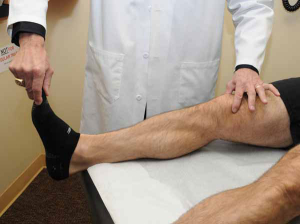One of the first assessments we do in the evaluation of a patient is to assess their amount of hyperextension. It is important to have the patient relaxed while performing this assessment. In general, we lift the ankle or the great toe while providing a stabilizing force to the distal thigh to determine the amount of hyperextension, or genu recurvatum, present. The amount of hyperextension is measured in negative “-” degrees, while a lack of full extension is measure in positive “+” degrees. Limitations of knee extension in younger patients may be due to osteochondritis dissecans, a mild amount of arthritis, or a locked meniscus tear.
About the Author: Robert LaPrade, MD
Robert LaPrade, MD, PhD has specialized skills and expertise in diagnosing and treating complicated knee injuries. He has treated athletes at all levels, including Olympic, professional and intercollegiate athletes, and has returned numerous athletes back to full participation after surgeries. Recognized globally for his outstanding and efficient surgical skills and dedication to sports medicine, he has received many research awards, including the OREF Clinic Research Award considered by many a Nobel Prize in orthopedics. Dr. LaPrade is one of the most published investigators in his field, and many of the surgeries that he has developed are now performed worldwide and recognized as the “gold standard” for the treatment of complex knee injuries.

